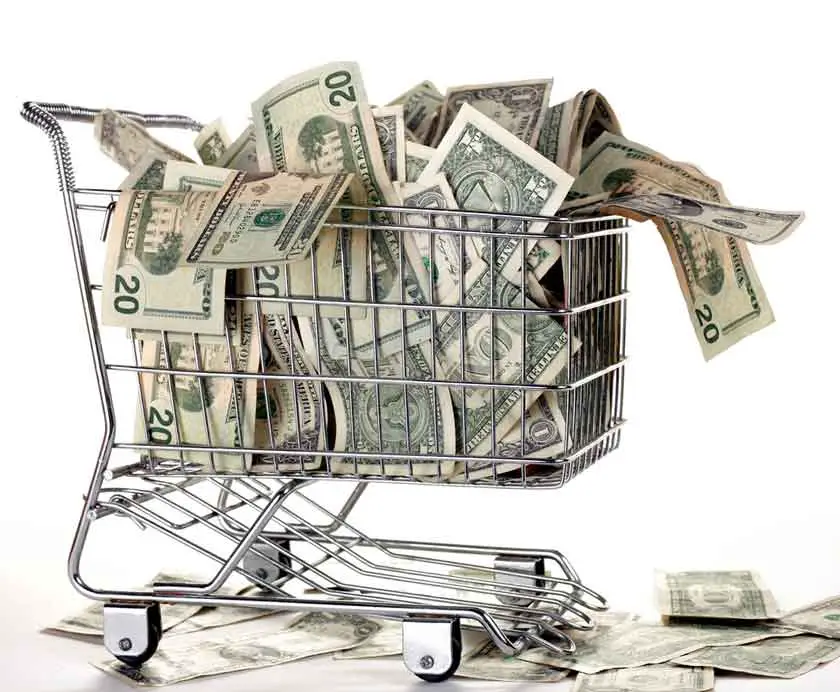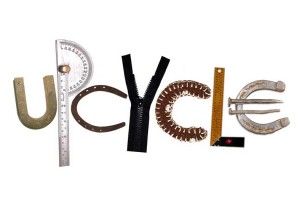I may get commissions for purchases made through links in this post.

Want to save thousands of dollars on grocery shopping? Here’s a ton of tips. Learn how to avoid the psychological tactics stores use to lure you into buying more than you intended. Find out how to buy your food for the lowest price possible. Become aware of little known tricks to get the most out of your money.
Whether you live alone or you’re cooking for ten, there are a lot of actions that will save you big bucks on your grocery bills. Many of these tricks you can do before you even get to the store. You’ll also find tips for while you’re in the market, once you start cooking and some general money-saving measures. Together these tips will help you stretch your dollars further than you thought possible.
Some of these tricks you may already know and use. Others may be eye-openers to you. Read on for a truly comprehensive guide to saving money on grocery shopping and keeping your hard-earned cash in your wallet!
Before the Store
Check Online Offers for Your Store
Many stores these days offer great online coupons on their website, as well as personalized deals that you can click on to save to your account.
While there may be a number of bargains that you aren’t interested in at the moment, it’s a good idea to save anything that looks of interest on the off-chance that you’ll need to pick it up on one of your next couple of trips.
Take Stock of What You Have
Check out your cupboards, fridge and freezer to see what you do have on-hand before you go to the store. This will keep you from doubling up unnecessarily on perishable items that you’ll only have to toss later and it will give you an idea of which items you’re about to run out of.
Keep a Running List
Some people like to have a magnetized notepad on the refrigerator, while others prefer to store a list in their phone. Whichever method you use, it’s a good idea to keep a running list of the staples that you’re out of readily available.
This will save you the time of trying to remember these things and you’ll be less likely to forget something, which will cause you to need to make another run to the store and spend more than you had planned.
Plan Your Meals
It may sound like something your grandmother would’ve done, but planning your meals out in advance is a great way to save cash. If you’ll base your plans on what you already have in your pantry and what’s on sale at your grocery store this week, you’ll wind up saving money twice.
If you have kids, ask them to help you plan the meals. They’ll be happy to have a say in what they’re going to eat and you’ll be considerably less likely to be forced to throw out food that wasn’t eaten.
Write Out A Shopping List
Having a shopping list in your hand will keep you on task, speed up your shopping and save you a lot of money on every trip to the grocery store. Use your knowledge of your local market to write it out based on the layout of the store so you won’t be zigzagging all over the place.
Again, you’ll save a lot more time and it will help you to avoid going down the cookie aisle, where you’ll be tempted to spend money on foods that aren’t good for you and that aren’t on your list.
Set a Budget
If you’ve been shopping for very long, you’re probably fairly aware of how much money you normally spend on a trip to the market. You can actually set a goal to be under this by $20 (or whatever is doable for your household’s needs) and then make it your mission to meet that goal. Whatever budget you set for yourself, be sure that you stick to that number or come in lower.
One modern trick that might help with this is to shop online. This will allow you to see what your total is before you actually check out, so that you can go back and delete unnecessary items to get back down to the amount you’ve set.
Even if you don’t want to actually buy your groceries online, this tool can be used to make a “dry run” through your market and set your initial budget. Online is the one time that it’s perfectly acceptable to just ditch your cart at the checkout and move on without buying a thing.
Look for Coupons on Your Favorite Brands
Clipping coupons can still save you big money, especially if you prefer to use name brand products. Check your mail, the Sunday papers and online sources for coupons on those items that you know you’ll use.
Manufacturers’ websites often carry generous coupons, as do individual stores, and more and more brands are offering great deals in exchange for a ‘Like’ or other shout-out on social media platforms.
Just be sure that you don’t get caught up with buying something simply because you have a coupon for it. If it’s something that you or your family won’t use, it stops being a bargain and is nothing more than a waste of money.
Comparison Shop
Just because you love the fact that a store has a gourmet coffee bar in the front or it has a better selection of breakfast cereals is not a reason to go there. In fact, these types of perks are precisely the ones that can wind up making it the most expensive store to shop in.
If you have more than one grocery store near you, be sure to do a little comparison shopping to find out which one gives you the best savings on the items that you buy the most.
Research has found that most people look at the prices of bread, eggs, milk and bananas to compare prices, but you should really go by the products that you use most often to gauge which store is right for your needs.
Use grocery shopping apps
Grocery Pal shows you where the sales products are, Apples2Oranges compares prices so you can see which item gives you the most bang for your buck, Key Ring replaces all those reward cards on your keyring, and Coupon Sherpa finds coupons. Other popular apps are Ibotta, SavingStar, Southern Savers, Shopmium, Favado, Groupon Snap, and Receipt Hog.
Eat Before You Shop
Never go to the market while you’re hungry. Studies indicate that people do a lot more impulse buying when their stomachs are growling. Who hasn’t experienced this themselves? So always make it a point to have a light snack before you hit the stores.
In The Store
Beware the Giant Shopping Cart (it’s so big for a sneaky reason)
You may have noticed that grocery store shopping carts seem to be getting bigger and bigger with every passing year. As it turns out, they are. This trend is due to the fact that grocery chains have found that when we have a larger cart, we’re more inclined to try to fill it up and, therefore, spend more money in their stores.
Use a hand basket when you can but if that’s not possible, simply being aware of this fact can help you resist the urge to keep adding more items to your cart just to fill it up.
Start in the Middle of the Store (they are manipulating you like The Amazing Kreskin)
Another psychological trick grocery stores use is to put the produce and bakery departments near the entrance in order to get you in the mood to buy right off the bat. The bright colors of the fruits and vegetables and the enticing aromas wafting from the ovens both work to this effect and can convince you to spend more money without you ever realizing what’s going on.
Instead, go straight to the middle of the store first, where less enticing boxes and cans await and you can keep your head straight. By the time you reach the produce and bakery sections, you’ll be more inclined to buy only what you need and head for the checkout.
[bctt tweet=”Supermarkets put nicely scented flowers and baked goods near the entrance to trick you into making impulse purchases ” via=”no”]
Ask When Markdowns Happen
Most stores have a relatively set schedule for when they mark their items down. For example, the butcher on the morning shift may be the one responsible for discounting the cuts of meat that are expiring the next day or the bakery worker who closes might routinely mark down all of the day’s bread that didn’t sell.
If you can find out when they occur and plan your shopping trips accordingly, you’ll have the best selection to choose from.
It’s probably advisable to ask these employees or a manager when the discounts are made, since the cashiers may not know or might be preoccupied with getting you out of there so they can clear the line behind you.
Most market employees will be all too happy to share this information with you though, since their goal is to move these items out as quickly as they can.
Stick to Your Shopping List
Remember that shopping list that you so diligently pulled together? Well, sticking to it is the best way of ensuring that all that work pays off. Use your list to guide you through the store and avoid tempting impulse buys that can wreck your budget in a heartbeat.
Listen to Upbeat Music
A lot of grocery chains employ the sneaky strategy of playing music on their intercoms that has a slow and relaxing beat because it makes people relax and want to spend more time (and money!) in their stores. Instead, take your iPod and listen to upbeat music through your earphones that will keep you moving at a faster pace.
Your workout mix can serve as a very good reminder to steer clear of the ice cream freezer as well. Do be mindful of other shoppers though and try to keep your volume turned down low enough that you can hear in-store announcements about last-minute specials going on.
[bctt tweet=” Shopping Tip: Avoid supermarket music. Studies show slow music makes people take their time and spend more money. “]
Shop Every Aisle of the Store
This isn’t something that you’ll want to do every time that you go to the store, but initially, you should make it a point to go down every aisle of your store in order to become more familiar with what items are available at lower prices in different departments.
Nuts tend to be cheaper on the baking aisle than they are in the snacks section, for example, while olives can often be found for a lot less in the world foods aisle than on the aisle with the salad fixings.
Some stores also have one aisle dedicated to bulk items, where you could find a great deal on a large jar of mayonnaise or pickles that you won’t see elsewhere in the store.
Buy Canned or Frozen
Canned and frozen foods often get a bad rap from foodies who insist that fresher is better, but the truth is that these items can be just as good for you as fresh, and a whole lot cheaper as well. Bear in mind that most canned or frozen foods are packaged while they are fresh, which will seal in a lot of the nutrients and flavor.
Fresh foods meanwhile, particularly produce that is out of season, may have taken a very long trip in order to make it to your local store’s produce section.
Buy Versatile Ingredients
Look for ingredients that you’ll be able to use as a reliable substitute in your favorite recipes. Greek yogurt is a fantastic addition to any fridge, since it can be eaten plain or dressed up with fruit for a dessert. It can also be used to make a deliciously creamy pasta sauce or to make a dip for chips or vegetables.
Regular flour is another staple that can easily be used in a variety of baking recipes, including as a substitute for bread flour, simply by adding some baking powder at the time that you decide to bake.
Avoid the Ends of the Aisles
Stores tend to put some of their most expensive products on these attention-getting displays, so avoid the temptation to grab something just because it’s handy. You’ll almost always find better deals when you stick to shopping in the aisles instead.
Look Up and Down
Once you’re on the aisles, be sure to look at the top and bottom shelves for the products with the best prices. Many markets place the priciest items at eye-level, since that’s where the gaze of most shoppers will remain. Just looking a little harder at what’s available can really save you big money once you reach the checkout.
[bctt tweet=”Grocery saving tip: Be aware that the supermarket checkout line is designed for maximum temptation.”]
Buying in Bulk Doesn’t Always Save
Most stores these days display the cost per oz or 100g alongside the total price of the item. Use this tool to determine whether or not buying a big block of cheese is actually more cost-effective than a smaller one.
While many people just assume that the larger packages of a product cost less per unit than the smaller convenience packets, you might be surprised to find that this isn’t always the case.
Even if an item is a penny or two cheaper in the bigger size, be sure that it’s something that you’re actually going to use up, since tossing an unused portion will destroy any small savings that you do get from buying a larger portion.
Do the Math
On top of the cost per unit, do a little quick math to see how many meals you can get from a product and determine if it’s really worth the money. A bag of frozen strawberries that you can get five smoothies from is definitely a better deal than a cheaper (but smaller) bag of raspberries that will only give you two servings.
[bctt tweet=”In small letters, price labels show you the cost per unit of weight. Compare different brands and sizes to save on groceries.”]
Look Out for the Deli Section
Surprisingly, you can often find much better deals on deli items just by looking in the dairy case or in the lunchmeat section. A lot of stores these days will wrap up prepackaged portions of their deli meats and cheeses and put them out for sale in these other departments as a way to move them a little faster.
Because they’re prepackaged, these packets are generally at least a little cheaper than the price per unit that you’ll find in the deli section and you won’t have to wait in line for them to be sliced.
Buy Now, Pick Up Later
Some stores with bakery departments will let you pay for an item and then pick it up later, often up to a month in advance. Ask the employee in your bakery section if their store has this policy and then take advantage of it when you see that an item you need is on sale before you actually need it.
This is an especially good strategy for birthday cakes and baked goods for holiday parties. Just be sure that you hold on to your receipt so that you won’t have any trouble claiming them when you come to pick them up.
Ask For Discounts
If you notice that a package of meat or a tray of dinner rolls is going to expire in the next day or so, ask an employee if it would be possible to get a discount on it. In all likelihood it was about to be marked down anyway and most stores would much rather have it go out the door at a reduced price than have to throw it in the trash.
Always Double-Check Sales Prices
It’s a good idea to get in the habit of taking a second look at sale prices before you put the item in your basket. Due to the fact that two different sizes of the same product are commonly placed next to one another on the shelf, it’s easy to mistake the sale sign on a smaller size for the larger one right next to it.
This isn’t an issue if you catch it at the register and request that it be taken back, but more often than not these kinds of mistakes will go unnoticed either until you get home or altogether. Better to double-check and save yourself the time, trouble and money before it becomes an issue.
Prepackaged Isn’t Always Best
Normally, buying apples or potatoes that have been prepackaged in a bag will be considerably cheaper than buying individual pieces of the same items, but that isn’t always the case. Do some quick math and make sure that you really are getting a better deal by buying prepackaged produce.
Multiples May Not Be Necessary For Savings
While a lot of stores advertise “2 for $5” or “10 for $10,” you may not have to buy two or ten of the items in order to realize a savings. Some items will ring up at the reduced price automatically, so you’ll get the discount on one item. Other chains will allow you to mix-and-match different items in order to get the better pricing.
Do Your Own Thawing
If you take a look at the “fresh” seafood display at your store, you may notice labels indicating that it was “previously frozen.” This is usually the very same seafood that you can buy frozen a few feet away, but at a much lower price.
Not only will you save money by buying the frozen variety, it will also normally taste fresher, since it won’t have been thawed out for as long if you done the job at home.
Buy Big Cuts of Meat
You can save a lot of money by buying a larger cut of meat and then letting the butcher to trim it up for you. Pick up a big roast and ask them to remove the bone, which you can use for a soup.
Then request that they run a portion of it through the grinder to use as hamburger and cut up the rest for a pot roast. This strategy can save you as much as 30% off what you would pay if you bought all three of these items on their own.
Avoid Impulse Buys
Hardcore frugalistas know how easy it is cut back on the amount of money you spend on impulse purchases by employing a 10-second rule. Hold the item in your hand for 10-seconds and try to think of a good reason that you need to have it. If you can’t come up with one in 10 seconds, put it back on the shelf where it belongs.
Stay Away from Convenience Foods
These are the frozen, freeze-dried and canned meals that you can throw in the microwave. They’re much more expensive than making food on your own and they’re generally pretty bad for your health. Making your own food from scratch is almost always better for your wallet and your waistline.
Stock Up On Sale Items
When something that you use on a regular basis goes on sale, grab a couple in order to save yourself from having to buy them at their normal price. If it goes on sale at a seriously deep discount, you may want to take as many as possible, since that could indicate that they’re being discontinued.
Of course, only employ this tactic if it’s a non-perishable item or something that you can freeze and store for later.
Read the Labels
Since the ingredients in a product are listed in order by their weight, you can ensure that you’re truly getting the best deal by reading the labels, particularly on canned items.
Take a look at the ingredients on two cans of tomatoes, for example. One can might be cheaper than the other, but if ‘water’ is listed before ‘tomatoes,’ it probably means that you’re not getting such a great bargain after all.
Use Seasonal Produce
Fruits and vegetables are generally considerably cheaper during their season, so try to work summer produce into your menu during the hotter months and cool season veggies in when it’s cold out. Besides saving money, you’ll probably also be eating fresher produce, since it won’t have to come from another part of the world where it is in season.
Take A Final Look In Your Cart
Before you head to the checkout line, do a quick survey of your shopping cart and cull out anything that you put there in a moment of weakness. Of course, the civilized thing to do is either put it back in its rightful place yourself or hand it off to an employee and ask politely that they return it to the shelf.
Whatever you do, don’t just set down products that need refrigeration on a shelf and walk away. If it spoils before someone notices it, it’ll have to be tossed and cost the store money. While it may seem like a small thing, this kind of waste is inevitably passed on to shoppers somewhere down the line.
Go Alone
There are a couple of good reasons to go to the grocery store on your own. First of all, the more people who tag along, the more likely it will be that unplanned items make it into your cart.
Whether it’s your significant other or the kids, an extra person or two can also slow you down at the market. Try to head to the store while they’re at work, in school or hanging out with friends. This trick alone can save a lot of money on any type of shopping trip, grocery or otherwise.
Go for Store Brands
Store brands very often contain the same ingredients that you’ll find in the pricier name brand items. The reason that they’re less expensive lies in the fact that they aren’t marketed as heavily, so you aren’t paying for bloated advertising budgets or premium labeling materials.
Try generic items in place of well-known brand name products and see if you can really tell a difference. If you can’t, there’s simply no reason to continue paying more.
[bctt tweet=”Grocery saving tip: going down a brand can save you a lot and may taste just as good”]
Sale Does Not Automatically Mean Bargain
Don’t be suckered into buying something just because it’s been marked down. Often, even the sale price on an expensive name brand product is still more than you would pay for its generic counterpart, so if it’s something like rice, flour or sugar, just go for the off-brand. You’ll never be able to tell the difference.
You should also ask yourself, is the item something that you were going to buy anyway? Or even something that you’ll use? Buying something that you really don’t have any use for simply because it’s been discounted is still a waste of money.
Look at the Expiration Dates
The best place to look for the latest expiration dates is usually toward the back of the display, since stores pull items that are about to expire to the front in order to move them out the door.
A later date will give you more time to use or freeze the product and reduce the odds that you’ll need to throw it out due to spoilage. Know the difference between ‘Best Before’, ‘Display Until’, and ‘Use By’. “Use by’ is the only one to look for, the others aren’t about food safety.
Be Realistic About What You’ll Actually Eat
Shoppers not only overbuy the foods they enjoy eating, many will consciously purchase foods that they don’t like in a fit of guilt about poor eating habits. While eating healthier is certainly a worthy goal and one that should be pursued, wasting both food and money is not the way to go about it (non-perishable foods you can always stock for emergency purposes).
It may seem obvious, but don’t go out and buy a bunch of food that you truly can’t stand eating with the idea that you’ll suddenly be inspired to eat better because it’s all you have in the fridge. (you may be surprised how many people do this, I did it myself too.) If anything, this strategy will backfire with the food going bad and you making a desperate run for takeaway or some other convenient but unhealthy and expensive fare.
Instead, sit down and come up with a list of healthy foods that you do like and try to find new ways of preparing them so that you don’t get bored. Work in new items that you aren’t as sure about a little bit at a time and cook them using spices and herbs that you find appealing.
A funny trick of the human body is that the more grease, sugar and fat that we eat, the more of it we want. On the flip side, the more fruits and vegetables that we eat, the more appealing these foods become to our palates. Start slowly and work your way into better eating habits a little bit at a time and you can save a lot of money in the process.
Once You’re Home
Use Your Freezer
Don’t let food go bad in the fridge when you have an empty freezer that you could store it in instead. If you can see that you’ve purchased too much of something, stick it in the freezer, where it can often last for months.
Be sure to check the expiration dates on the food in your fridge on a regular basis, so you don’t accidentally wait too long and miss the chance to save some money.
Cook Only What You Need of Certain Foods
There’s no point in making big portions of foods that don’t hold up well in the refrigerator for more than a day or so and that are easy to prepare. Rice and oatmeal are both good examples of foods that are so simple to make and that taste so much better fresh, it only makes sense to make them in smaller batches when you need them.
This strategy will reduce the amount of food that you throw away and keep you from having to restock these items as often.
Bulk Cook Others
On the other hand, there are a lot of recipes that you can make in mass quantities at once and freeze, thereby cutting down on the amount of time, trouble and money that you have to put into them.
Making four casseroles or pans of lasagna is really no tougher than making one and you can easily store the extra portions in the freezer until you need a quick and easy dinner solution. If you bought the ingredients for these dishes when they were on sale, you could still be reaping the benefits of planning ahead many weeks later.
Basic Cost-Cutting Strategies
Limit Your Trips to the Store
Try to pick up everything you need in one run to the grocery store, since the more often you go, the more likely you’ll be to spend extra money. Think about all the times that you’ve darted out to the market with the intention of grabbing two or three items and then come out with ten.
These quick runs also tend to be the ones where we’re more susceptible to impulse buys, so it really is in your best financial interest to avoid making them whenever you can.
Reduce Your Delivery Charges
If you need to have your groceries delivered to your home, there are a couple of different strategies that can help to cut the costs of this service. Schedule them during off-times, like mid-week or later in the evening when most grocery stores have lower delivery fees.
You can also search online for free delivery promo codes for your store or ask the store manager if there is free delivery you’re your order gets to a certain amount.
Use the 1-Month Coupon Strategy
Because the makers of many products actually have a system for pushing new items or specific products, it can really pay off to wait to use your coupons for a few weeks after they arrive. Save your coupons for approximately a month and then start looking in the store ads in your area.
You’ll very often see that these same items go on sale at around that time, as manufacturers move on to the next phase of their marketing plan. Use the coupons in conjunction with the sale price and voila! You’ve managed to save money twice without having to do any serious legwork.
Drink More Water
This is an old weight-loss trick that is also an effective way to stretch your dollars. Drinking a glass of water a few minutes before every meal will cut back on the amount of food that you eat and the amount of money that you spend on food. Even better, you’ll be well-hydrated and able to drop weight without ever feeling hungry. Of course tap water is the frugal choice (bottled water is a thousand times more expensive), do make sure to have a good water filter at home.
Eat Breakfast
This is another method for losing weight that can seriously cut your bills at the grocery store. Eating a healthy breakfast will fuel you for what is typically the most active part of your day and cut down on the amount of food that you eat at lunch and dinner.
It also revs up your body’s metabolism, which will help to trim your waistline overtime. Try to go with foods that are high in fiber and that offer some lean protein, both of which will keep you feeling full for longer.
Slow-cooked oatmeal, a piece of fruit and a boiled egg is a nutritious and inexpensive way to start your day and this combo will leave you feeling satisfied well into the time for lunch.
Dress Up Leftovers
Leftovers present a great way to finish off food that would otherwise go to waste, but many people think of them as nothing short of culinary punishment. If the thought of leftovers just doesn’t appeal to you, try punching them up with fresh ingredients or making something entirely new out of them.
For example, a roasted chicken could be added to a fresh pasta dish or used to make a chicken salad sandwich. Use your imagination and do a little experimenting and you’ll probably be surprised to discover that leftovers can be used to make dishes that are both tasty and convenient.
Brown Bag Lunch
You can also use those leftovers for your work lunch the next day, which will not only save you from having to toss them in the garbage bin, but also help you to curb spending on less healthy restaurant and takeaway foods.
A brown bag lunch doesn’t have to be a sandwich every day either. If you portion out those casseroles that you made in bulk into smaller containers, they’ll make a fast, easy and delicious lunch that just needs to be popped into the microwave for a few minutes. Even better for the environment and your wallet, use a lunch box, it’s one of the 38 frugal products that will save you money.)
Invest in a Deep Freezer
Once you make the initial investment in it, a deep freezer can save you a lot of money over time. You can store larger cuts of meat that you find on sale in one, as well as foods that you’ve prepared ahead of time.
Maximize your savings by getting an energy efficient model and storing plastic jugs filled with water in any empty space to cut down on power usage even further.
Get a Crock Pot
Crock pots offer up a great method for making soups, stews and sauces using in-season produce and cuts of meat that you’ve found on sale. You can then freeze and enjoy these meals when the price of the ingredients has gone back up. They will also make fantastic brown bag lunches that can often cost less than a dollar per serving to make.
Pack Food Before a Road Trip or Outing
If you know that you’re going to be away from home for more than a few hours, be sure to take some food along with you in order to avoid having to spend big money in a restaurant or convenience store. Dried fruit, nuts and crackers don’t need refrigeration in order to stay good and they can keep you full until you can make it back home.
If you’re hitting the road for a long while, take along sandwiches, some sliced cheeses or some pre-cut veggies in a small cooler.
Make Your Own Beer and Wine
Making your own spirits is actually not that hard to do and it can be a fun and cost-effective alternative to the brands that you’ll find in the store. It does take a little time, so plan ahead if you know that you want to have a couple of bottles of vino at your next dinner party.
There is an abundance of information on making your own beer and wine online and most of them will cost you considerably less than even the cheapest bottles of alcohol at the market.
Plant a Garden
Nothing is more gratifying than growing your own herbs and vegetables and homegrown produce is usually much more flavorful than anything that you can get at the store. Even if you think that you don’t have room for a large garden, you might be surprised to find out that you can grow a lot of edible plants in containers.
Even dwarf variety fruit trees can be grown in pots, so head over to your local nursery and find out what types of food will grow well in your area and when the best time to plant them will be. Or start extra small yet space-efficient by growing microgreens.
Substitute Recipe Ingredients
Get familiar with inexpensive foods that you can use as substitutes for pricier options. Lemon juice works great as a vinegar substitute and can also be used in place of pricy cream of tartar, so having some around can wind up saving you big money.
You can also usually substitute in-season produce in the place of more expensive off-season goods, which is also usually a healthier way to go. There are a number of food substitution charts online, substitution apps that will keep you from having to waste money experimenting to find out what will work and what won’t. If you’re serious about it, get the best selling Food Substitutions Bible.
Eat Less Meat
Meat tends to be the most expensive way of getting protein in your diet, so try to cut back on the amount that you eat. You can get plenty of lean and healthy protein just by eating more eggs, beans and edamame, all of which will also save you a lot of money at the grocery store.
Sign Up for Rewards Cards
Many grocery chains these days have some sort of a rewards program to serve as an incentive for shopping in their stores. These rewards may range from bigger in-store discounts or free grocery delivery to savings on gas at certain stations.
Look for those that offer something that you’ll use and that are reasonably close to home. If you tend to shop in one store most of the time, the rewards that you’ll see can stack up fairly quickly and help you to save big money in the long run.
Go For More Nutritional Value
Frugal celebrities and penny pinching millionaires know this, and now do you too. Nutritionally-dense foods keep you from feeling hunger for longer, so making them a regular part of your diet is a good way to reduce your overall grocery bills. Fruits and vegetables are generally high in nutritional value, while convenience foods like chips, cookies and pre-packaged meals tend to be heavy in calories and low in nutrition.
Another useful rule of thumb:
the more vibrant color that you see in a piece of produce, the more nutrition it will carry. Remember too that when it comes to fruit, the skin is where most of the vitamins and fiber are, while the flesh is where you’ll find the highest concentrations of sugar.
Join Cashback Programs
Online resources like TopCashBack’s Snap and Save and Quidco’s ClickSnap offer cashback on purchases made in certain stores, so enrolling in these programs can be an effective means of regaining a little of what you spent at the market.
Each program has its own rules and regulations, so you’ll want to become familiar with them before you sign up, but either way you’ll enjoy the kick of earning money back with every trip to the store.
Venture Out
Going grocery shopping doesn’t have to mean going to the grocery store. Try heading to the seafood or the farmer’s market, the butcher shop, or an ethnic food store to find great deals on foods that you already buy or on something entirely foreign to you.
These outlets are not only good for bargains, you can usually find out new and interesting ways to cook inexpensive foods that you may not have thought of before. Ask the butcher for advice on preparing less costly cuts of meat or quiz the person selling seafood about fish choices that you’ve never heard of. This is a fantastic way to break out of a dining rut and try some new foods without having to spend an arm and a leg.
While each of these tips individually will certainly save you some money on your grocery bills, using a combination of as many of them as you can is without a doubt the fastest way to see your savings really start to add up.
Use these tips on how to save money on your grocery shopping every time you shop and you’ll be surprised to discover how much you cut your food costs over time.
Want more tips? Check out these 38 products that will save you money.
By Julie R.






















nice work